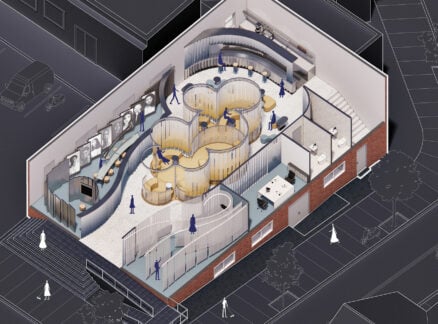August 1, 2006
Paying Proper Homage
A Modern preservationist and the original architect of his 1950s house collaborate on a new landscape that honors the spirit of the past without slavishly reproducing it.
Chris Menrad was just weeks away from finishing the renovation of his Palm Springs vacation home—a sleek, low-slung Butterfly house built in 1957 by Alexander Homes, one of the biggest single-family-house developers of the Modernist era. The outside walls were painted in shades custom-mixed to match precisely the original colors. The plywood siding that previous tenants tacked onto the carport was knocked out and replaced with the original Tectum, a wood-fiber panel commonly used as insulation. A carefully edited collection of period furniture filled the bright rooms.
But the front yard was a mess. He decided to do the job himself, with a little help from William Krisel, the original creator of Menrad’s Butterfly house, who designed scores of others in housing developments from Palm Springs to Los Angeles and from the San Fernando Valley to San Diego. At first Krisel wanted nothing to do with the project. “I’ve had so many calls from people just looking for free advice,” says the 81-year-old in his still-active Brentwood home office. “You help them, and then they go off and do whatever they want.” Fortunately, in discussions of paint colors and period details, Menrad—treasurer of the Palm Springs Modern Committee—managed to convince Krisel that he was a dedicated preservationist. Both say solemnly, “You don’t paint a mustache on the Mona Lisa.” Krisel adds, “You might, but I don’t have to look at it.”
While at USC in the 1940s, Krisel studied under Modern landscape pioneer Garrett Eckbo, a student of Bauhaus founder Walter Gropius. “I believed that Modern architecture didn’t end at the glass line,” Krisel says. “I did landscapes for my own projects to extend the design outward.” To begin the landscaping efforts, Menrad drew an Eckbo-influenced sketch, a Googie-style boomerang of grass in a gravel yard, and sent it to Krisel. “A week later,” Menrad marvels, “this really incredible drawing came in the mail. It’s so complex, it’s baroque practically.”
Echoing a landscape of concrete circles that he originally designed for the Alexanders’ own house—still standing just a block away from Menrad’s—Krisel created a grid of crushed brick and white marble, surf greenstone, and gray gravel, overlaid with an arc of grass “lily pads” of varying sizes. The quadrants of the grid line up exactly with the poured concrete rectangles of the driveway as well as the panels of the house and sliding carport doors. “The parti anchors it to the house; then I took the circles of grass and just sort of went off into space,” Krisel says.
Krisel still had the firm’s original color schedule for the Twin Palms development, one of three that he did with Alexander Homes in Palm Springs that included versions of the Butterfly house. Working off of that, he specified a border of heavenly bamboo and papyrus, and a quadrant of pink petunias. Menrad refined the sketch slightly, eliminating one of the grass pads, nixing Krisel’s suggestion that they border the largest pad in brick, and switching out the petunias for a pink clover that is more suited to the desert climate. In a final iteration Krisel reshaped the circles of grass, changing the layout so that all of the center points were aligned. Some of the yard’s existing features—three boulders, cactus, juniper, and a stand of palm trees—were incorporated into the design. The result is a front yard as Mondrian might have painted it, both modern and Modernist—where, owner and architect agree, they’ve managed to create something new that revives the spirit of the original.





